Marketing Report: Nike's Customer Equity Model and Objectives Analysis
VerifiedAdded on 2023/04/21
|22
|3974
|471
Report
AI Summary
This report provides a comprehensive marketing analysis of Nike, examining its current market position, market segmentation, and targeting strategies. It delves into Nike's customer-based equity model (CBBE), exploring the elements of resonance, judgments, feelings, performance, and imagery. The report outlines Nike's marketing objectives, including improving market share and brand awareness, along with the identification of key target segments such as the 18-25 age group, high-income individuals, and those with an athletic lifestyle. Additionally, the report discusses Nike's strategic three-year horizon based on McKinsey's framework, encompassing maintaining the core business, nurturing emerging businesses, and creating new business ventures. The report also provides a detailed examination of Nike's marketing mix, including product, price, place/distribution, and promotion strategies, concluding with a review of Nike's overall marketing efforts and their impact on the company's success.

Marketing
2 / 2 2 / 2 0 1 9
2 / 2 2 / 2 0 1 9
Paraphrase This Document
Need a fresh take? Get an instant paraphrase of this document with our AI Paraphraser
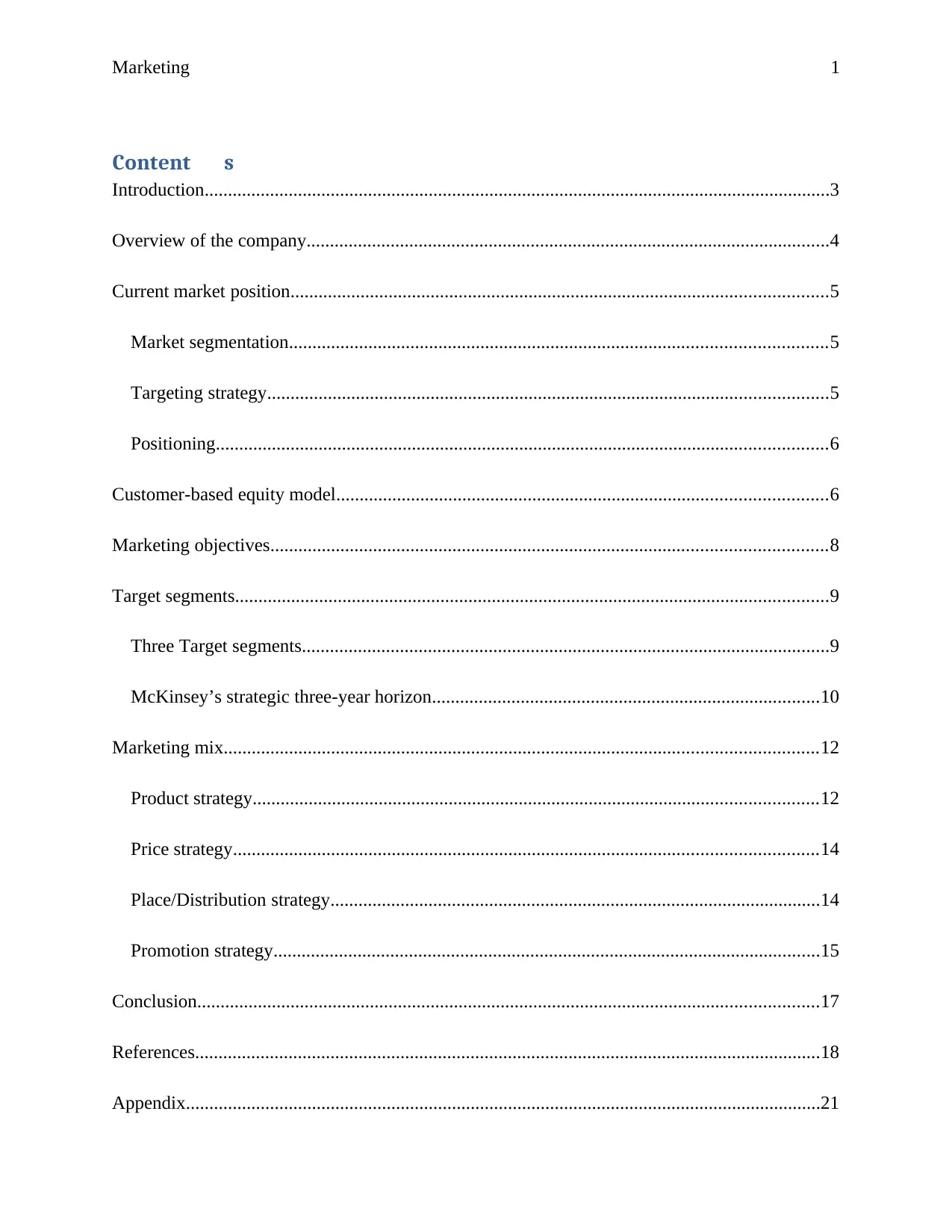
Marketing 1
Content s
Introduction......................................................................................................................................3
Overview of the company................................................................................................................4
Current market position...................................................................................................................5
Market segmentation...................................................................................................................5
Targeting strategy........................................................................................................................5
Positioning...................................................................................................................................6
Customer-based equity model.........................................................................................................6
Marketing objectives.......................................................................................................................8
Target segments...............................................................................................................................9
Three Target segments.................................................................................................................9
McKinsey’s strategic three-year horizon...................................................................................10
Marketing mix...............................................................................................................................12
Product strategy.........................................................................................................................12
Price strategy.............................................................................................................................14
Place/Distribution strategy.........................................................................................................14
Promotion strategy.....................................................................................................................15
Conclusion.....................................................................................................................................17
References......................................................................................................................................18
Appendix........................................................................................................................................21
Content s
Introduction......................................................................................................................................3
Overview of the company................................................................................................................4
Current market position...................................................................................................................5
Market segmentation...................................................................................................................5
Targeting strategy........................................................................................................................5
Positioning...................................................................................................................................6
Customer-based equity model.........................................................................................................6
Marketing objectives.......................................................................................................................8
Target segments...............................................................................................................................9
Three Target segments.................................................................................................................9
McKinsey’s strategic three-year horizon...................................................................................10
Marketing mix...............................................................................................................................12
Product strategy.........................................................................................................................12
Price strategy.............................................................................................................................14
Place/Distribution strategy.........................................................................................................14
Promotion strategy.....................................................................................................................15
Conclusion.....................................................................................................................................17
References......................................................................................................................................18
Appendix........................................................................................................................................21

Marketing 2
Appendix 1.................................................................................................................................21
Appendix 2.................................................................................................................................22
Appendix 3.................................................................................................................................22
Appendix 1.................................................................................................................................21
Appendix 2.................................................................................................................................22
Appendix 3.................................................................................................................................22
⊘ This is a preview!⊘
Do you want full access?
Subscribe today to unlock all pages.

Trusted by 1+ million students worldwide

Marketing 3
Introduction
The aim of the report is to explore the concepts of the marketing manager for the selected
company. The company that has been selected for the analysis is Nike, which is a multination
company that is engaged in designing, developing and manufacturing of footwear, apparel,
equipment, accessories, and services. The marketing consultant has prepared a report that
includes the five major aspects of marketing management.
Introduction
The aim of the report is to explore the concepts of the marketing manager for the selected
company. The company that has been selected for the analysis is Nike, which is a multination
company that is engaged in designing, developing and manufacturing of footwear, apparel,
equipment, accessories, and services. The marketing consultant has prepared a report that
includes the five major aspects of marketing management.
Paraphrase This Document
Need a fresh take? Get an instant paraphrase of this document with our AI Paraphraser

Marketing 4
Overview of the company
Nike is well known American Multination Corporation that indulges in designing, production,
marketing with the trades of footwear, accessories, equipment, apparel, and services. The
company was originated by Bill Bowerman and Phil Knight as Blue Ribbon Sports in the year
1964. This has been found that in 2014, the Nike brand was appreciated at $19 billion due to
which it is considered as the most valuable brands among the sports-related businesses (Nike,
2018). In addition to this, the company implement the acquisition strategy that reduce the
competition, enhance the brand value and deals with the competition. This has been witnessed
that the company has acquired footwear companies like Cole Haan, Umbro, and many others.
However, the company sold Umbro in 2012 and Cole Haan in 2013, along with this company has
a subsidiary of Hurley international. The company is considered as the world's largest dealers of
athletic shoes and apparel with a dominant producer of sports equipment.
Overview of the company
Nike is well known American Multination Corporation that indulges in designing, production,
marketing with the trades of footwear, accessories, equipment, apparel, and services. The
company was originated by Bill Bowerman and Phil Knight as Blue Ribbon Sports in the year
1964. This has been found that in 2014, the Nike brand was appreciated at $19 billion due to
which it is considered as the most valuable brands among the sports-related businesses (Nike,
2018). In addition to this, the company implement the acquisition strategy that reduce the
competition, enhance the brand value and deals with the competition. This has been witnessed
that the company has acquired footwear companies like Cole Haan, Umbro, and many others.
However, the company sold Umbro in 2012 and Cole Haan in 2013, along with this company has
a subsidiary of Hurley international. The company is considered as the world's largest dealers of
athletic shoes and apparel with a dominant producer of sports equipment.
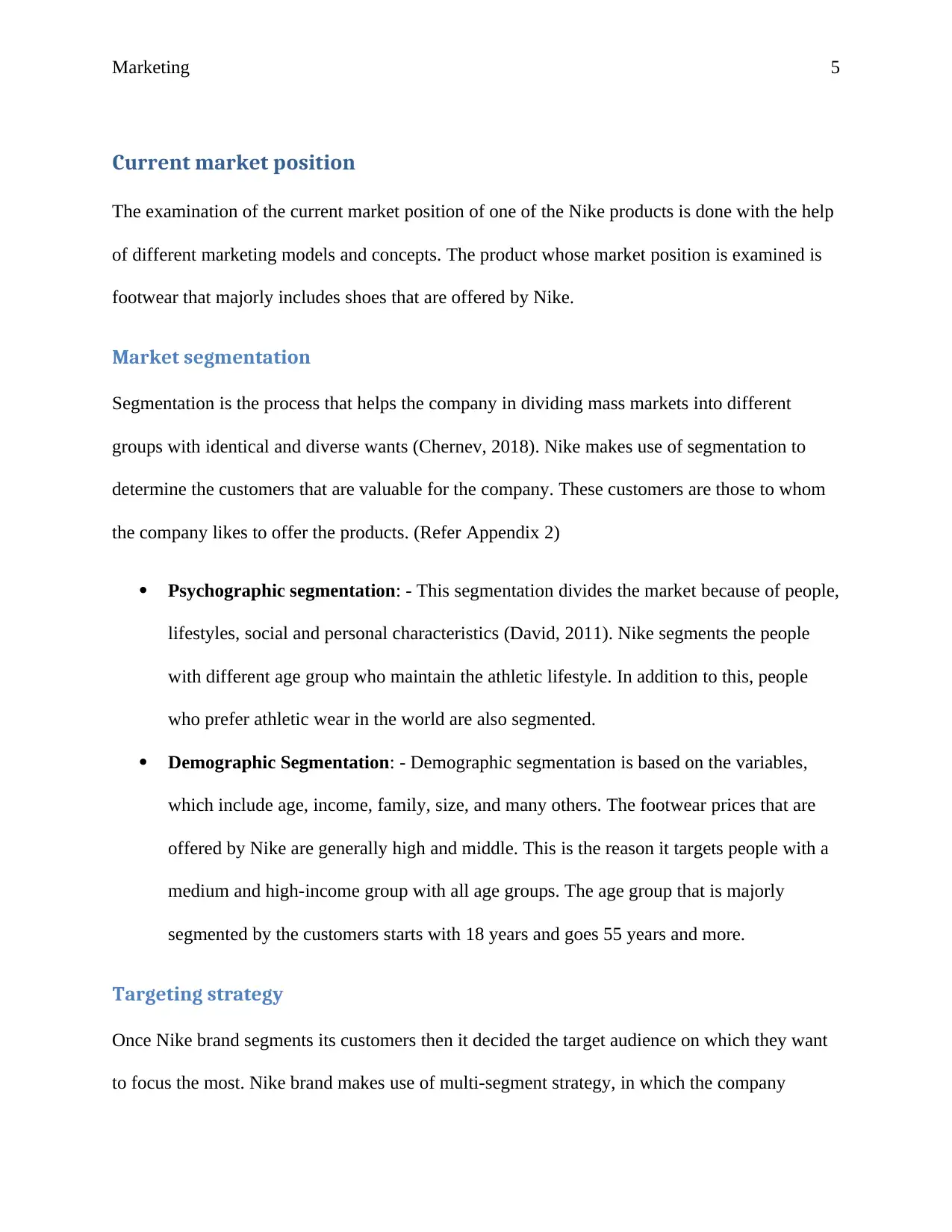
Marketing 5
Current market position
The examination of the current market position of one of the Nike products is done with the help
of different marketing models and concepts. The product whose market position is examined is
footwear that majorly includes shoes that are offered by Nike.
Market segmentation
Segmentation is the process that helps the company in dividing mass markets into different
groups with identical and diverse wants (Chernev, 2018). Nike makes use of segmentation to
determine the customers that are valuable for the company. These customers are those to whom
the company likes to offer the products. (Refer Appendix 2)
Psychographic segmentation: - This segmentation divides the market because of people,
lifestyles, social and personal characteristics (David, 2011). Nike segments the people
with different age group who maintain the athletic lifestyle. In addition to this, people
who prefer athletic wear in the world are also segmented.
Demographic Segmentation: - Demographic segmentation is based on the variables,
which include age, income, family, size, and many others. The footwear prices that are
offered by Nike are generally high and middle. This is the reason it targets people with a
medium and high-income group with all age groups. The age group that is majorly
segmented by the customers starts with 18 years and goes 55 years and more.
Targeting strategy
Once Nike brand segments its customers then it decided the target audience on which they want
to focus the most. Nike brand makes use of multi-segment strategy, in which the company
Current market position
The examination of the current market position of one of the Nike products is done with the help
of different marketing models and concepts. The product whose market position is examined is
footwear that majorly includes shoes that are offered by Nike.
Market segmentation
Segmentation is the process that helps the company in dividing mass markets into different
groups with identical and diverse wants (Chernev, 2018). Nike makes use of segmentation to
determine the customers that are valuable for the company. These customers are those to whom
the company likes to offer the products. (Refer Appendix 2)
Psychographic segmentation: - This segmentation divides the market because of people,
lifestyles, social and personal characteristics (David, 2011). Nike segments the people
with different age group who maintain the athletic lifestyle. In addition to this, people
who prefer athletic wear in the world are also segmented.
Demographic Segmentation: - Demographic segmentation is based on the variables,
which include age, income, family, size, and many others. The footwear prices that are
offered by Nike are generally high and middle. This is the reason it targets people with a
medium and high-income group with all age groups. The age group that is majorly
segmented by the customers starts with 18 years and goes 55 years and more.
Targeting strategy
Once Nike brand segments its customers then it decided the target audience on which they want
to focus the most. Nike brand makes use of multi-segment strategy, in which the company
⊘ This is a preview!⊘
Do you want full access?
Subscribe today to unlock all pages.

Trusted by 1+ million students worldwide

Marketing 6
different segments for offering the products and services (Rothaermel, 2015). The segments,
which are majorly focused, include youth and athletics that majorly look to buy the Nike brand
products. The age group, which is focused by Nike, is 18-25 years and 25-45 years. Moreover,
Nike majorly focuses on youth who are athletics.
Positioning
The positioning statement of Nike Brand is “For serious athletes, Nike gives confidence that
provides the perfect shoe for every sport”. In the present competitive environment, the brand is
considered as one of the major global leaders that deal in the sporting goods industry that has
majorly formed a strong positioning in promoting the lifestyle that is followed by athletic. The
brand positioning defines that it is the number one sports manufacturer across the world. In
addition to this, the brand is considered as one of the leading goods company that has its
existence in the United stated and a hundred and ten countries (Wilson and Gilligan, 2012). Nike
brand has gained the positioning in the brand by becoming the passion for every customer to
make use of products that form the Nike Just Do It feeling for being competitive.
Nike is focused on the perception of the customers towards the brand as perception can influence
the buying decision related to the sports industry. The brand has been able to position to the
opportunities of customers and athletic fantasy that is majorly endorsed by the real athletes. This
also shows that the brand is more focussed towards the athlete that affects the other people. In
addition to this, this makes the customers feel that their expectation with the brand is not
valuable.
different segments for offering the products and services (Rothaermel, 2015). The segments,
which are majorly focused, include youth and athletics that majorly look to buy the Nike brand
products. The age group, which is focused by Nike, is 18-25 years and 25-45 years. Moreover,
Nike majorly focuses on youth who are athletics.
Positioning
The positioning statement of Nike Brand is “For serious athletes, Nike gives confidence that
provides the perfect shoe for every sport”. In the present competitive environment, the brand is
considered as one of the major global leaders that deal in the sporting goods industry that has
majorly formed a strong positioning in promoting the lifestyle that is followed by athletic. The
brand positioning defines that it is the number one sports manufacturer across the world. In
addition to this, the brand is considered as one of the leading goods company that has its
existence in the United stated and a hundred and ten countries (Wilson and Gilligan, 2012). Nike
brand has gained the positioning in the brand by becoming the passion for every customer to
make use of products that form the Nike Just Do It feeling for being competitive.
Nike is focused on the perception of the customers towards the brand as perception can influence
the buying decision related to the sports industry. The brand has been able to position to the
opportunities of customers and athletic fantasy that is majorly endorsed by the real athletes. This
also shows that the brand is more focussed towards the athlete that affects the other people. In
addition to this, this makes the customers feel that their expectation with the brand is not
valuable.
Paraphrase This Document
Need a fresh take? Get an instant paraphrase of this document with our AI Paraphraser

Marketing 7
Customer-based equity model
Keller's brand equity model is majorly known as CBBE (customer-based equity model). The
evolution in marketing has made the customer a major focus of the company. CBBE model is a
pyramid to form brand equity by understanding the consumers and creating the strategies
accordingly. The CBBE model includes five major elements like Resonance, judgements,
feelings, performance, and imagery. The below-given image shows the CBBE model in Nike: -
Resonance: - People are loyal to a brand or loyal to the sports shoe industry irrespective
of the brand that shows their resonance towards footwear industry. Sports athletics who
are the major customers of Nike find this brand different from other brands. The brand
Customer-based equity model
Keller's brand equity model is majorly known as CBBE (customer-based equity model). The
evolution in marketing has made the customer a major focus of the company. CBBE model is a
pyramid to form brand equity by understanding the consumers and creating the strategies
accordingly. The CBBE model includes five major elements like Resonance, judgements,
feelings, performance, and imagery. The below-given image shows the CBBE model in Nike: -
Resonance: - People are loyal to a brand or loyal to the sports shoe industry irrespective
of the brand that shows their resonance towards footwear industry. Sports athletics who
are the major customers of Nike find this brand different from other brands. The brand
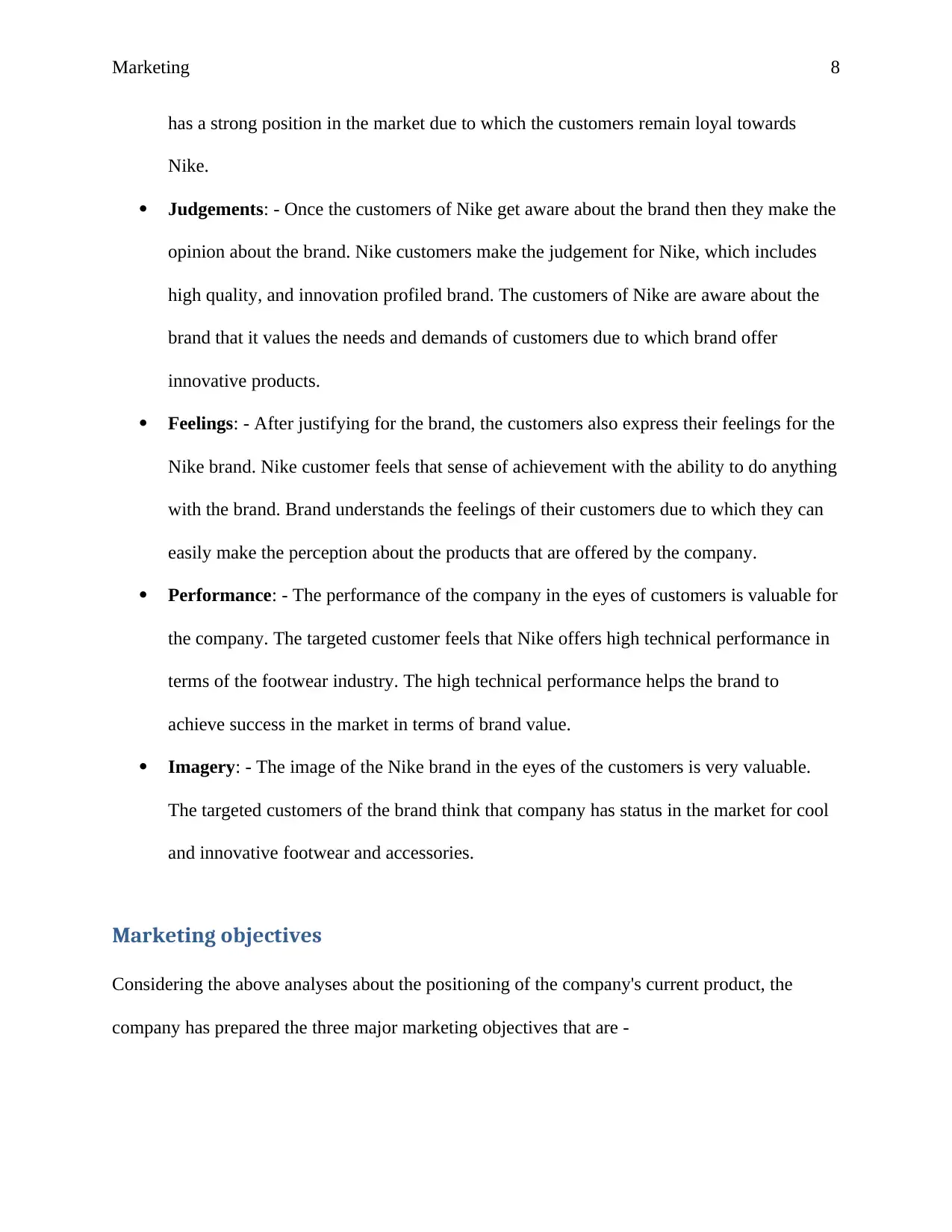
Marketing 8
has a strong position in the market due to which the customers remain loyal towards
Nike.
Judgements: - Once the customers of Nike get aware about the brand then they make the
opinion about the brand. Nike customers make the judgement for Nike, which includes
high quality, and innovation profiled brand. The customers of Nike are aware about the
brand that it values the needs and demands of customers due to which brand offer
innovative products.
Feelings: - After justifying for the brand, the customers also express their feelings for the
Nike brand. Nike customer feels that sense of achievement with the ability to do anything
with the brand. Brand understands the feelings of their customers due to which they can
easily make the perception about the products that are offered by the company.
Performance: - The performance of the company in the eyes of customers is valuable for
the company. The targeted customer feels that Nike offers high technical performance in
terms of the footwear industry. The high technical performance helps the brand to
achieve success in the market in terms of brand value.
Imagery: - The image of the Nike brand in the eyes of the customers is very valuable.
The targeted customers of the brand think that company has status in the market for cool
and innovative footwear and accessories.
Marketing objectives
Considering the above analyses about the positioning of the company's current product, the
company has prepared the three major marketing objectives that are -
has a strong position in the market due to which the customers remain loyal towards
Nike.
Judgements: - Once the customers of Nike get aware about the brand then they make the
opinion about the brand. Nike customers make the judgement for Nike, which includes
high quality, and innovation profiled brand. The customers of Nike are aware about the
brand that it values the needs and demands of customers due to which brand offer
innovative products.
Feelings: - After justifying for the brand, the customers also express their feelings for the
Nike brand. Nike customer feels that sense of achievement with the ability to do anything
with the brand. Brand understands the feelings of their customers due to which they can
easily make the perception about the products that are offered by the company.
Performance: - The performance of the company in the eyes of customers is valuable for
the company. The targeted customer feels that Nike offers high technical performance in
terms of the footwear industry. The high technical performance helps the brand to
achieve success in the market in terms of brand value.
Imagery: - The image of the Nike brand in the eyes of the customers is very valuable.
The targeted customers of the brand think that company has status in the market for cool
and innovative footwear and accessories.
Marketing objectives
Considering the above analyses about the positioning of the company's current product, the
company has prepared the three major marketing objectives that are -
⊘ This is a preview!⊘
Do you want full access?
Subscribe today to unlock all pages.

Trusted by 1+ million students worldwide
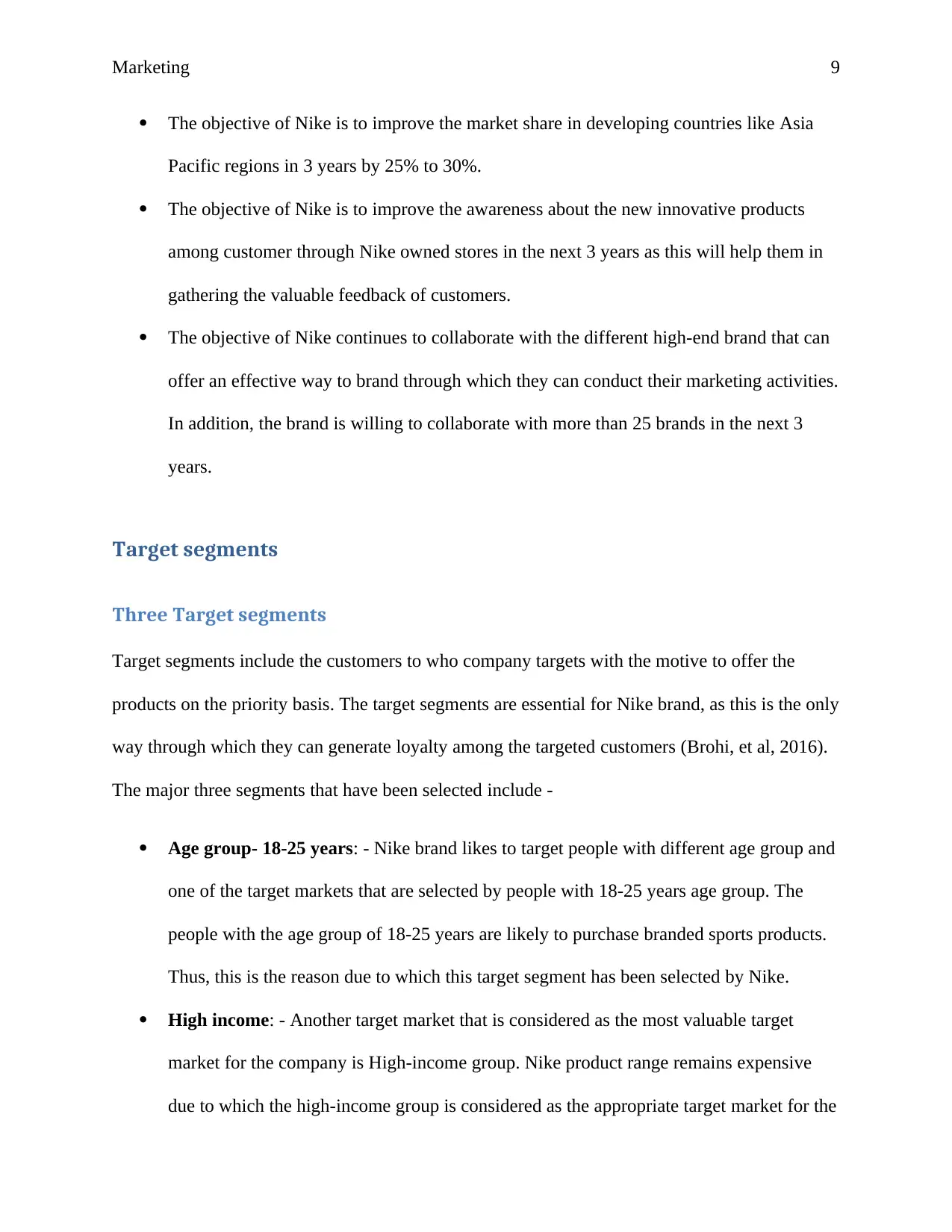
Marketing 9
The objective of Nike is to improve the market share in developing countries like Asia
Pacific regions in 3 years by 25% to 30%.
The objective of Nike is to improve the awareness about the new innovative products
among customer through Nike owned stores in the next 3 years as this will help them in
gathering the valuable feedback of customers.
The objective of Nike continues to collaborate with the different high-end brand that can
offer an effective way to brand through which they can conduct their marketing activities.
In addition, the brand is willing to collaborate with more than 25 brands in the next 3
years.
Target segments
Three Target segments
Target segments include the customers to who company targets with the motive to offer the
products on the priority basis. The target segments are essential for Nike brand, as this is the only
way through which they can generate loyalty among the targeted customers (Brohi, et al, 2016).
The major three segments that have been selected include -
Age group- 18-25 years: - Nike brand likes to target people with different age group and
one of the target markets that are selected by people with 18-25 years age group. The
people with the age group of 18-25 years are likely to purchase branded sports products.
Thus, this is the reason due to which this target segment has been selected by Nike.
High income: - Another target market that is considered as the most valuable target
market for the company is High-income group. Nike product range remains expensive
due to which the high-income group is considered as the appropriate target market for the
The objective of Nike is to improve the market share in developing countries like Asia
Pacific regions in 3 years by 25% to 30%.
The objective of Nike is to improve the awareness about the new innovative products
among customer through Nike owned stores in the next 3 years as this will help them in
gathering the valuable feedback of customers.
The objective of Nike continues to collaborate with the different high-end brand that can
offer an effective way to brand through which they can conduct their marketing activities.
In addition, the brand is willing to collaborate with more than 25 brands in the next 3
years.
Target segments
Three Target segments
Target segments include the customers to who company targets with the motive to offer the
products on the priority basis. The target segments are essential for Nike brand, as this is the only
way through which they can generate loyalty among the targeted customers (Brohi, et al, 2016).
The major three segments that have been selected include -
Age group- 18-25 years: - Nike brand likes to target people with different age group and
one of the target markets that are selected by people with 18-25 years age group. The
people with the age group of 18-25 years are likely to purchase branded sports products.
Thus, this is the reason due to which this target segment has been selected by Nike.
High income: - Another target market that is considered as the most valuable target
market for the company is High-income group. Nike product range remains expensive
due to which the high-income group is considered as the appropriate target market for the
Paraphrase This Document
Need a fresh take? Get an instant paraphrase of this document with our AI Paraphraser
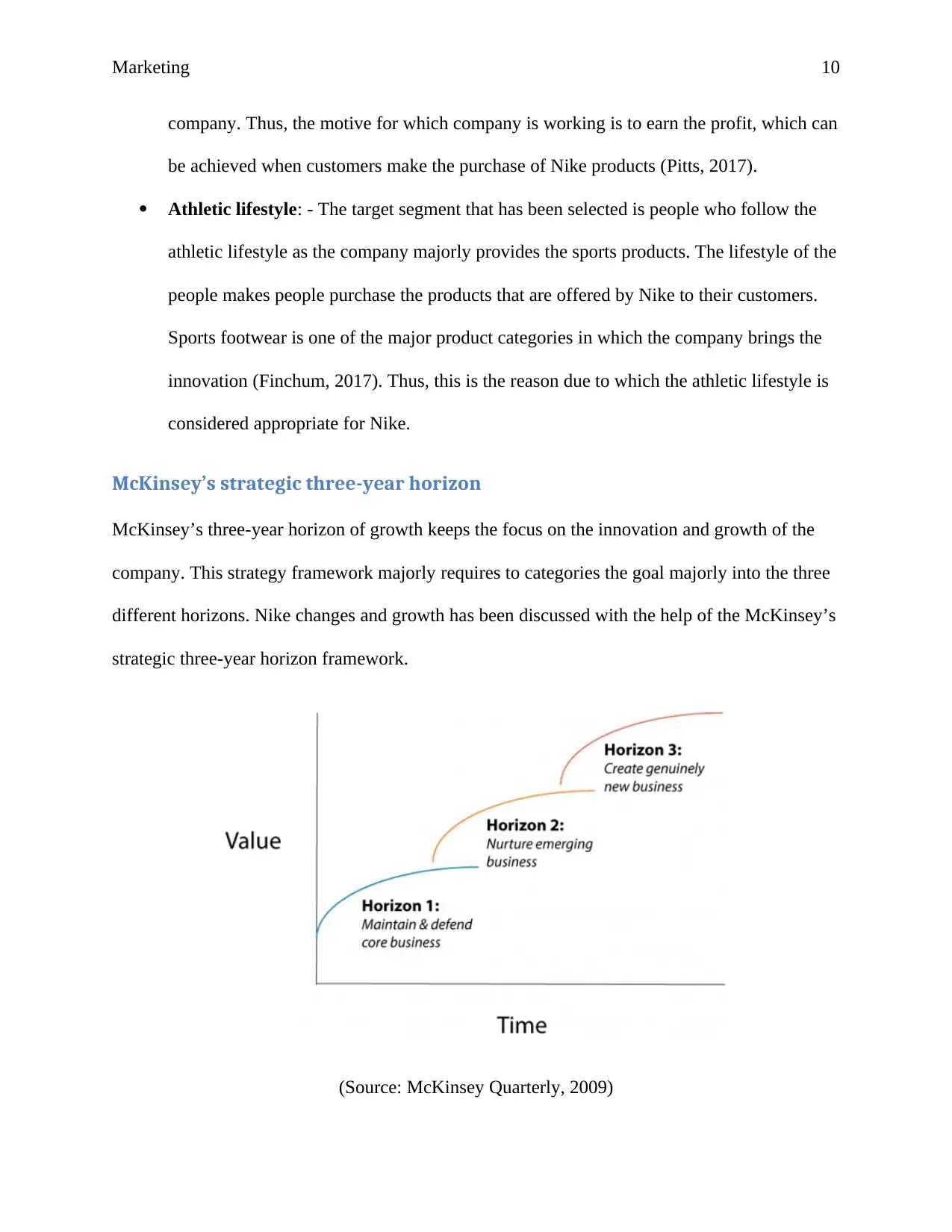
Marketing 10
company. Thus, the motive for which company is working is to earn the profit, which can
be achieved when customers make the purchase of Nike products (Pitts, 2017).
Athletic lifestyle: - The target segment that has been selected is people who follow the
athletic lifestyle as the company majorly provides the sports products. The lifestyle of the
people makes people purchase the products that are offered by Nike to their customers.
Sports footwear is one of the major product categories in which the company brings the
innovation (Finchum, 2017). Thus, this is the reason due to which the athletic lifestyle is
considered appropriate for Nike.
McKinsey’s strategic three-year horizon
McKinsey’s three-year horizon of growth keeps the focus on the innovation and growth of the
company. This strategy framework majorly requires to categories the goal majorly into the three
different horizons. Nike changes and growth has been discussed with the help of the McKinsey’s
strategic three-year horizon framework.
(Source: McKinsey Quarterly, 2009)
company. Thus, the motive for which company is working is to earn the profit, which can
be achieved when customers make the purchase of Nike products (Pitts, 2017).
Athletic lifestyle: - The target segment that has been selected is people who follow the
athletic lifestyle as the company majorly provides the sports products. The lifestyle of the
people makes people purchase the products that are offered by Nike to their customers.
Sports footwear is one of the major product categories in which the company brings the
innovation (Finchum, 2017). Thus, this is the reason due to which the athletic lifestyle is
considered appropriate for Nike.
McKinsey’s strategic three-year horizon
McKinsey’s three-year horizon of growth keeps the focus on the innovation and growth of the
company. This strategy framework majorly requires to categories the goal majorly into the three
different horizons. Nike changes and growth has been discussed with the help of the McKinsey’s
strategic three-year horizon framework.
(Source: McKinsey Quarterly, 2009)
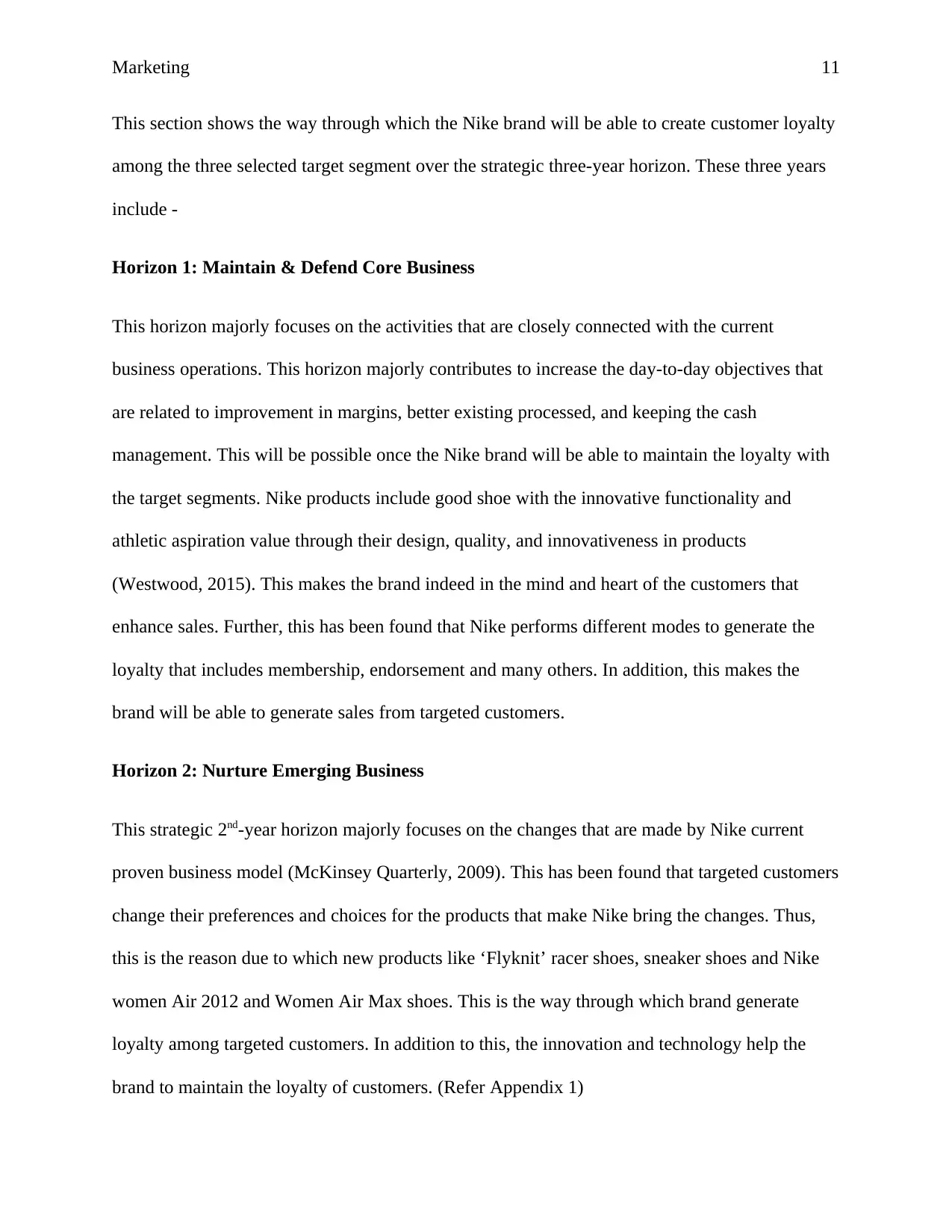
Marketing 11
This section shows the way through which the Nike brand will be able to create customer loyalty
among the three selected target segment over the strategic three-year horizon. These three years
include -
Horizon 1: Maintain & Defend Core Business
This horizon majorly focuses on the activities that are closely connected with the current
business operations. This horizon majorly contributes to increase the day-to-day objectives that
are related to improvement in margins, better existing processed, and keeping the cash
management. This will be possible once the Nike brand will be able to maintain the loyalty with
the target segments. Nike products include good shoe with the innovative functionality and
athletic aspiration value through their design, quality, and innovativeness in products
(Westwood, 2015). This makes the brand indeed in the mind and heart of the customers that
enhance sales. Further, this has been found that Nike performs different modes to generate the
loyalty that includes membership, endorsement and many others. In addition, this makes the
brand will be able to generate sales from targeted customers.
Horizon 2: Nurture Emerging Business
This strategic 2nd-year horizon majorly focuses on the changes that are made by Nike current
proven business model (McKinsey Quarterly, 2009). This has been found that targeted customers
change their preferences and choices for the products that make Nike bring the changes. Thus,
this is the reason due to which new products like ‘Flyknit’ racer shoes, sneaker shoes and Nike
women Air 2012 and Women Air Max shoes. This is the way through which brand generate
loyalty among targeted customers. In addition to this, the innovation and technology help the
brand to maintain the loyalty of customers. (Refer Appendix 1)
This section shows the way through which the Nike brand will be able to create customer loyalty
among the three selected target segment over the strategic three-year horizon. These three years
include -
Horizon 1: Maintain & Defend Core Business
This horizon majorly focuses on the activities that are closely connected with the current
business operations. This horizon majorly contributes to increase the day-to-day objectives that
are related to improvement in margins, better existing processed, and keeping the cash
management. This will be possible once the Nike brand will be able to maintain the loyalty with
the target segments. Nike products include good shoe with the innovative functionality and
athletic aspiration value through their design, quality, and innovativeness in products
(Westwood, 2015). This makes the brand indeed in the mind and heart of the customers that
enhance sales. Further, this has been found that Nike performs different modes to generate the
loyalty that includes membership, endorsement and many others. In addition, this makes the
brand will be able to generate sales from targeted customers.
Horizon 2: Nurture Emerging Business
This strategic 2nd-year horizon majorly focuses on the changes that are made by Nike current
proven business model (McKinsey Quarterly, 2009). This has been found that targeted customers
change their preferences and choices for the products that make Nike bring the changes. Thus,
this is the reason due to which new products like ‘Flyknit’ racer shoes, sneaker shoes and Nike
women Air 2012 and Women Air Max shoes. This is the way through which brand generate
loyalty among targeted customers. In addition to this, the innovation and technology help the
brand to maintain the loyalty of customers. (Refer Appendix 1)
⊘ This is a preview!⊘
Do you want full access?
Subscribe today to unlock all pages.

Trusted by 1+ million students worldwide
1 out of 22
Related Documents
Your All-in-One AI-Powered Toolkit for Academic Success.
+13062052269
info@desklib.com
Available 24*7 on WhatsApp / Email
![[object Object]](/_next/static/media/star-bottom.7253800d.svg)
Unlock your academic potential
Copyright © 2020–2025 A2Z Services. All Rights Reserved. Developed and managed by ZUCOL.





